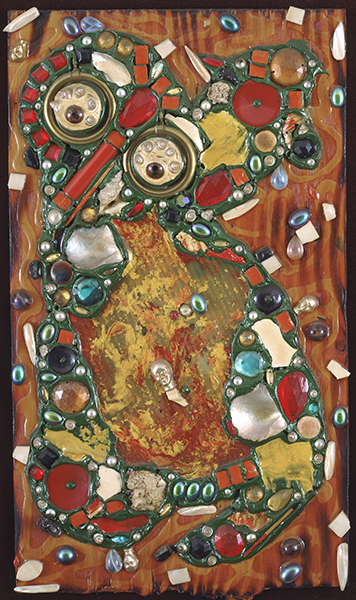Pride Month 2021 IV: Alfonso Ossorio
Alfonso Ossorio was one of the lesser-known rebels against American Abstract Expressionism, after briefly being under its sway. Like many of the gay artists on the periphery of Abstract Expressionism, he found the homophobia of the main stars of the movement, who were touted by art dilettante Clement Greenberg (1909–1994), disturbing. His ultimate work was a direct challenge to the aesthetics of the overwhelmingly straight-male-dominated movement.
 |
| Alfonso Ossorio (1916–1990, U.S., born Philippines), In a Wood Lightly, 1962. Synthetic polymer paint with sea shells and plastic objects on wood, 17 ½" x 9 5/8" (44.5 x 24.4 cm). The Museum of Modern Art, New York, Ruth Vollmer Bequest. © Estate of the Artist. (MOMA-P3964) |
After 1958, Ossorio moved away from his abstractions and began to create assemblages of all types of everyday, natural, and discarded objects. He called works such as In a Wood Lightly "congregations," vaguely referencing religion. Works like this incorporate spiritual imagery such as the yin and yang of Chinese philosophy, which had spiritual aspects attached to it by Confucianism. Like his paintings of his Abstract Expressionist period, Ossorio's assemblages are more or less closed compositions, often with symmetrically balanced placement of objects. There is a closed-in reference to Abstract Expressionism’s action painting in the center of the composition, which is overwhelmed by the objects around it.
Many of the modernist movements of the 1900s were reactions to traditional art or "traditional values." Surrealism was a reaction to the chaos caused by "logical" thinking that led to world war. Surrealist artists emphasized the beauty of subconscious rather than conscious creation. Abstract Expressionism, too, emphasized the superiority of art that expressed the subconscious rather than rational, planned composition. Jean Dubuffet (1901–1985), whose style was dubbed Art Brut, proposed that there was validity to art inspired by the mentally ill and others whose work was not considered "fine art." Ossorio's highly personal abstraction is a bridge between these three ways of thinking.
Ossorio was born in Manila and educated at Catholic boarding schools in the Philippines as a young child. Between the ages of 8 and 13, he attended the same type of schools in Britain. At 14, he moved to the U.S. and studied at a Catholic school in Providence, Rhode Island, where he graduated in 1934. Ossorio then studied fine art at Harvard University from 1934 to 1938.
Surrealism heavily influenced Ossorio's work of the 1940s. He produced highly detailed, dream-like imagery in a realistic style. His combination of unrelated objects and figures were often tinged with religious symbolism, based on his Catholic upbringing. After 1945, he became friends with Jackson Pollock (1912–1956), the Abstract Expressionist. The two artists mutually influenced each another.
After meeting Pollock, Ossorio abandoned his Surrealist imagery for abstract and non-objective works that reflected the gestural aspect of Pollock's work, although exercised with more restraint. He was attracted to the Abstract Expressionist intent to thumb their nose at traditional artistic preconceptions. He poured enamel and paint on his canvases much as Pollock did, although with more control and closed compositions.
In 1950, Ossorio spent a protracted length of time in Paris. While there, he met and was influenced by Dubuffet's assemblages, which incorporated common elements such as sand and garbage.
Correlations to Davis programs: A Personal Journey 2E: 9.6; Experience Painting: Chapter 9; The Visual Experience 4E: 10.7; Exploring Visual Design 4E: Chapter 6


Comments